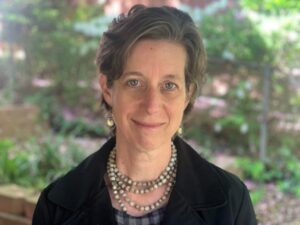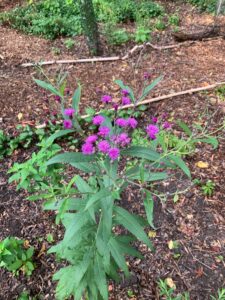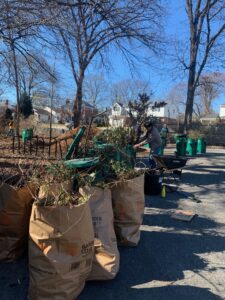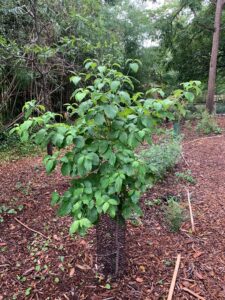Mira Grieser and Kimberly Schmidt have been working to transform Hyattsville Mennonite Church’s back swamp into a native species habitat. Mira shares about their progress thus far.
This article was originally published in Hyattsville Mennonite Church’s monthly newsletter, HYMN volume 31, issue 3: April 2024. Republished with permission.
 Mira Grieser is a longtime gardener, who only recently began to realize that plants in our landscapes need to do more than just look good; they also need to support pollinators, absorb rainfall, sequester carbon and mitigate climate change. She lives in Mount Rainier, Maryland, a stone’s throw from Washington, D.C., with her husband and 2 daughters. They attend Hyattsville (Maryland) Mennonite Church. Mira attended Goshen (Indiana) College and Christopher Dock Mennonite High School (now Dock Mennonite Academy).
Mira Grieser is a longtime gardener, who only recently began to realize that plants in our landscapes need to do more than just look good; they also need to support pollinators, absorb rainfall, sequester carbon and mitigate climate change. She lives in Mount Rainier, Maryland, a stone’s throw from Washington, D.C., with her husband and 2 daughters. They attend Hyattsville (Maryland) Mennonite Church. Mira attended Goshen (Indiana) College and Christopher Dock Mennonite High School (now Dock Mennonite Academy).
___________________________________
For many years, most of us at Hyattsville Mennonite Church have hurried past the part of our property behind the parking lot, barely glancing over to see the mass of vines growing out of areas of standing — or sometimes rushing — water. With a closer look, a person might notice that English ivy vines were crawling up tree trunks, layers of euonymus vines covered the ground and bush honeysuckle had spread rampantly. The vines had already brought down some of the medium-sized trees, and these invasive plants were providing very little benefit to the ecosystem.
One Sunday in fall 2023, Kimberly Schmidt, another longtime HMC member, and I found ourselves staring into the impassable, impenetrable “Back Swamp,” and realized that there was a great opportunity for transformation. Kim and I are both habitat advisors with the Prince George’s County Wildlife Habitat Program. Through this volunteer work, we provide consultations with homeowners on ways to provide beneficial and beautiful habitats on their properties by incorporating native plants.

A flowering plant in HMC’s restored swamp.
Photo provided by Mira Grieser.
With that spark of an idea and a significant amount of hard work from many HMC attendees, this parcel of urban tree canopy has started an incredible transformation toward a healthy and thriving ecosystem that supports all levels of plant, insect and bird life in Hyattsville. This work aligns well with what we, and many communities of faith, see as a call to be stewards of the environment and care for creation.
This work starts with native plants and trees that have evolved with native wildlife to create an intricate ecosystem. Attracting pollinators is a key function of plants, which then can support all types of life.
While there is a tendency to view this area’s sogginess as a negative, we see it’s important function — to be able to absorb runoff from surrounding areas — and keep the water on the property, rather than running it into the sewers, washing topsoil and trash into the rivers. Many native plants have deep root systems, which can help manage runoff. In contrast, the invasive vines and bush honeysuckle have shallow roots.
The timing of this project is great, because many urban municipalities are looking for ways to preserve and enhance their tree canopy, recognizing that trees can mitigate some of the effects of climate change. There have been studies that have found as much as a 25-degree difference in air temperature under a tree, compared with air temperatures over a blacktop.
Together, HMC has accomplished the following items on this project so far:
- We held three workdays in the winter and early spring 2024, focusing on invasive plant removal. Fifteen people can make a lot of progress in a couple of hours, pulling out vines, digging out roots and running a woodchipper! We filled 60+ bins with vines and other invasive species, which were then picked up by the City of Hyattsville and transported to the Prince George County organic composting location. This was not easy work, as there were brambles and poison ivy, but people came out and worked hard!
-

Members of HMC work to clear invasive species out of the swamp to make room for native species to flourish.
Photo provided by Mira Grieser.We cleared some dead and dying medium-sized trees, thanks to the professional efforts and chainsaw of forester Alex Navari, and created a wood chip path that encourages people to wander through the woods, while keeping their feet dry.
- The City of Hyattsville planted 20 trees for us! We chose a variety of species, such as bald cypress and black willow, which will develop extensive root systems, to better absorb water and support an incredible variety of insect and bird species. The trees were all free to HMC, supported by funds made available by the American Rescue Plan Act, which helps preserve the urban tree canopy. We have made valuable connections with administrators for the City of Hyattsville, who are supportive of these efforts!
- We met with folks from Chesapeake Natives, and other local native plant advisors, for ideas on areas of focus. In exchange for the use of the HMC building for one of their meetings earlier this year, Chesapeake Natives has given HMC some plants.
- We have started adding other natives, as they are available. Many folks within the church and in the local native plant community have been happy to share starts. So far, we have obtained all of the following plants, which support pollinators, including native bees, flies, butterflies and moths, and bloom at different times:
- Shrubby St. John’s wort, cardinal flower, goldenrod, asters, sensitive ferns, cut-leaf coneflower, golden ragwort, black-eyed Susans and brown-eyed Susans, 10-petal sunflowers, giant yellow hyssop, and pawpaw trees.
- Amazingly, once the invasive vines were off the soil, we started to see native plants sprouting. We now have tiny redbud trees and oak trees, Virginia creeper, and pokeweed.
- Summer 2024 has turned into a very challenging season for new plantings, with the mid-Atlantic drought and extremely high temperatures. Somewhat ironically, we spent a lot of time watering the “swamp.” Regular, deep watering is crucial for the first two to three years, while the young trees get established. Kim and I were joined by another HMC member, Su Flickinger, for early morning watering and weeding twice each week throughout the summer.

A tree planted in HMC’s restored swamp. Photo provided by Mira Grieser.
Throughout this first year, there has been much enthusiasm from the congregation and the neighbors. Children love running through the path on Sunday mornings, and some have helped shovel woodchips during workdays. We had an outdoor service adjoining the Back Swamp to celebrate nature. Almost every Sunday, there are people checking out the progress. In the late summer, as people visited with one another after church, a zebra swallowtail butterfly swooped in and settled on a little pawpaw tree. The pawpaw is the only host plant for these beautiful black and white striped butterflies.
Certainly, there will be challenges ahead in keeping the momentum going. Yet in this time when it’s easy to feel overwhelmed by climate change, this is one area that we do have control over, and we can make a difference. And it has been inspiring to discover that we are joining the efforts of other faith communities, municipalities and individuals, hopeful that, together, we can make a bigger change.
For more information:
- Check out “Nature’s Best Hope: A New Approach to Conservation That Starts in Your Yard” by Douglas W. Tallamy.
- Take a look at Homegrown National Park, a grassroots call to action for land owners to plant native plants and remove invasive species with a goal of achieving 20 million acres of native plantings in the US.
- Read about other communities of faith getting involved with native plant gardens here.
The views and opinions expressed in this blog belong to the author and are not intended to represent the views of the MC USA Executive Board or staff.

